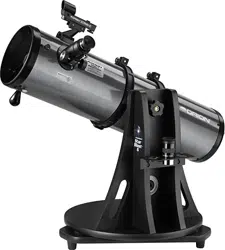Loading ...
Loading ...
Loading ...

19
The Guide Arrows
The controller leads you to astronomical targets with guide
arrows displayed on the LCD screen. After an object is select-
ed to view, you will see two guide arrows, one that points left
or right, and one that points up or down. Move the telescope
tube in the corresponding direction of the guide arrows. If you
are standing to the left of the telescope and facing the same
direction the telescope is pointed, the guide arrows will exactly
correspond with the direction you should move the telescope
(Figure 25). Otherwise, if an up arrow is displayed, move the
telescope tube upward, if a down arrow is displayed, move the
telescope tube downward, if a left arrow is displayed, rotate the
telescope counterclockwise, and if a right arrow is displayed,
rotate the telescope clockwise. There is a number next to each
guide arrow that indicates how far the telescope needs to be
moved to reach the selected object. As you move the tele-
scope toward the object, this number will decrease. When the
number goes below ten, the figure will be displayed in tenths;
this helps to make small, precise movements to the telescope
tube in order to bring the object into your field of view. When
both numbers reach zero, stop moving the telescope. The
object will be within the field of view of a medium- to low-power
eyepiece (25mm focal length or longer).
For example, look at Figure 26a, which shows the LCD screen
for someone trying to locate M51, otherwise known as the
Whirlpool Galaxy. The first arrow is pointing right and gives a
number of 34. The second arrow is pointing up and displays
the number 12. This means that the telescope tube should be
moved to the right (clockwise) and up. When you are close to
M51, the numbers will be displayed in tenths, as is shown in
Figure 26b. When the numbers reach zero (Figure 26c), the
telescope will be pointed right at the Whirlpool Galaxy.
It is easiest to move the telescope in one direction at a time
(say altitude) until the corresponding number reached “0.0”.
Then move the scope in the other direction (azimuth) until that
number also reads “0.0”.
If the object selected to view is currently located below the
horizon, the word “HORIZON” will flash before the guide
arrows are displayed. Choose another object to view.
C. Locating the Planets
By far the most popular objects for viewing, after the Moon, are
the planets. Since the other eight planets in our solar system
are also orbiting the Sun, they do not appear in fixed positions
in the night sky like deep-sky objects and stars do. Because of
this, the controller requires you to input the date before it can
find the planets.
To find planets with your IntelliScope Computerized Object
Locator, use the following procedure:
1. Press the Planet button on the controller.
2. The LCD screen will display a date similar to the
following:
3. The number after the word “DATE” will be flashing and
represents the day of the month. Input the two-digit day
using the number buttons.
4. The three-letter month will now be flashing. Use the
arrow buttons to scroll to the present month and then
press the Enter button.
5. Now the year will flash. Input the year using the number
buttons.
If you make a mistake while inputting the date, press the Enter
button at any time while still within the Planet button function.
The LCD screen will then display the last date input, with the
two-digit day after the word “DATE” flashing. Input the correct
date as outlined above.
Now, to choose a planet to view, press the arrow buttons
and scroll through the planets. The planet’s name will be dis-
played in the upper left section of the LCD screen, with the
guide arrows on the upper right of the LCD screen. Move the
telescope in the corresponding direction shown by the guide
arrows.
The lower left screen shows the constellation that the planet
appears in, with its present co-ordinates given in right ascen-
sion and declination. When you are finished viewing the plan-
et, you may scroll to another planet by using the arrow buttons.
The features and details you can see will vary from planet to
planet. The following descriptions give a brief overview of what
to expect when viewing them:
MERCURY Mercury is often so close to the Sun that it cannot
be seen. Sometimes it is visible for a brief period after the Sun
sets, and sometimes it’s visible in the morning just before the
Sun rises. Mercury does not really show any detail, but is quite
bright. With your telescope, you will be able to investigate this
Figure 26. This sequence
of pictures illustrate how the
Computerized Object Locator’s
guide arrows look as you are
finding a celestial object. (a)
When the optical tube is aimed
far away from the object’s
location, there will be a number
(from 10 to 179) to the left of
the guide arrows. (b) When
the scope is aimed close to
the object, each guide arrow
will display a number on its
immediate left (from 0 to 9)
and immediate right (from 0
to 9); the number on the left is
whole number increments, while
the number on the right is in
increments of tenths. This helps
in making small movements to
the telescope to pinpoint the
object’s location. (c) When the
guide arrows display “0.0 0.0”,
the object will be within the
field of view of the telescope
(with a 25mm or longer focal
length eyepiece).
b.
c.
a.
Loading ...
Loading ...
Loading ...
